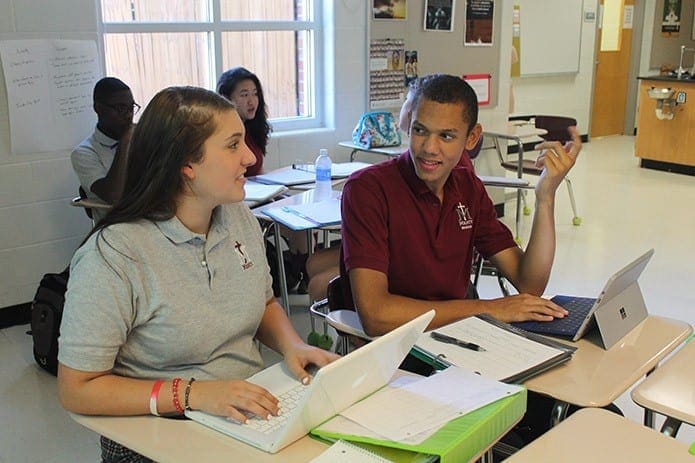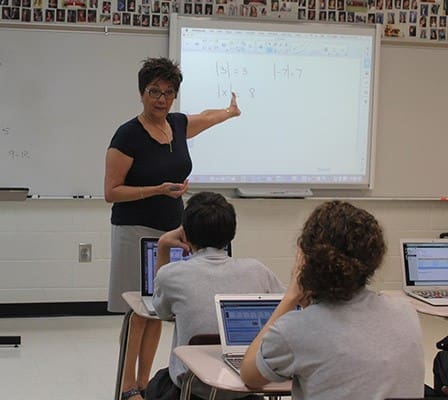
Fayetteville
Our Lady of Mercy High School implements all-digital campus with online textbooks
By NICHOLE GOLDEN, Staff Writer | Published September 4, 2015
FAYETTEVILLE—No more backpacks weighed down with heavy books for students at Our Lady of Mercy High School in Fayetteville.
After nearly three years of study by a parent-staff committee and a pilot project using digital textbooks in some classrooms, Our Lady of Mercy is now a totally digital campus. While all Catholic schools are using technology to provide more opportunities to students, OLM is the first archdiocesan high school to go totally online with textbooks.
A red banner in the front office heralds the arrival of 100 percent digital learning. It is expected to enhance student achievement and lower textbook costs for families.
“Every school wants to increase student engagement,” said Principal Brian Newhall. “The enemy is apathy.”
Instead of having to purchase individual textbooks for each subject, students can now access the books on laptops or tablets.
“That’s what they’re comfortable using,” said Newhall.
The principal visited Archbishop Stepinac High School in White Plains, New York, to see how that school implemented digital learning in 2013. He wanted to make it a reality, and he credits the committee of parents, teachers and administrators who championed the project and made it happen.
Pearson Education provides the digital library and uses the school’s student database to provide textbooks correlating with a student’s class schedule.
Newhall showed that the current price of one world geography textbook, a course he teaches, was $131.50. With five to six books to purchase, a family’s cost could easily be more than $500. By going digital, one advantage is cost savings. Parents are asked to pay $20 a month each school year for the digital capability.
Digital learning also allows students to have the latest, relevant information. If facts change for a government textbook, for instance, the new information can be added immediately to the digital book.
Newhall tested digital textbooks in one of his classes last year. A handful of other staff members joined a pilot run in their respective subjects.
“There were things it allowed us to do,” said Newhall.
Some of the extra features include the use of videos, audio narration of certain passages in the text, and assessments that students can take at home. The assessments give teachers automatic feedback about areas where students need additional work.
“Scores went up,” said Newhall.
Several students at Our Lady of Mercy received perfect scores on Advanced Placement tests last year, which Newhall attributes in part to the move toward digital learning.
Most classrooms at the archdiocesan high school already had interactive whiteboards that can be used in conjunction with digital textbooks.
“I think digital textbooks give you a little more of that flexibility,” said Newhall.
Teachers were offered additional training on smart boards to make full use of the new and existing resources.
Teachers asked to blog daily
Despite the move to a digital campus, Our Lady of Mercy is still a cell-phone free zone for the students. Cell phones can only be used before or after the official school day and must be turned off during the day.
Many colleges and universities are oriented around digital learning, and it calls for greater student accountability and challenges them to think in different ways.
“Are we ready to move away from memorization in education?” asked Newhall.
As part of the transition, instructors are also spending more time with technology by providing details about homework or projects online.
“All of our teachers have been asked to blog daily,” said Newhall.
That way there is no mistake about what assignments are and students can download assignments or needed materials straight from their teacher’s blog. Parents can access the blogs as well.
Any change in a student’s schedule is updated each evening so there is no lag time in a child having what they need to study.
All textbooks, except theology or religion books from St. Mary’s Press, are coming from Pearson.
A classroom set of books will be available for any student who forgets their device.
Assistant Principal JoAnn McPherson said there have been some minor bumps in the road, but overall the transition has gone well.
The students are even helping the teachers find creative ways to use the technology, or in solving problems.
“They’ve been generous with their talents,” said McPherson.

Ana DeMello, algebra and calculus teacher at Our Lady of Mercy High School in Fayetteville, stands before the interactive whiteboard in her classroom. The school recently became a 100 percent digital campus.
Mark Beno, director of operations, said teachers are learning new ways to teach and the move makes the school more competitive in the academic environment.
“We’ve also made investments in our infrastructure,” said Beno. The school is working to solve some bandwidth problems, but administrators knew hiccups would be part of the process.
“Sometimes, you’ve got to fall forward,” said Beno.
McPherson said that going digital helps students to be accustomed to taking responsibility for learning.
“It prepares the students very well for where they are going,” said McPherson.
Rebecca Miller was one of the parent members of the technology committee guiding the process.
“We did research on how other schools did it. Fayette (County) had gone digital the year before,” explained Miller.
The public school system first initiated a Bring Your Own Device (BYOD) policy, and Miller touched base with Whitewater High School’s principal to learn about their transition.
“I met with him to find out how they had done that,” she said.
Miller’s son graduated last year from Our Lady of Mercy and is now a freshman at Kennesaw State University, where he is making a good adjustment and completing papers ahead of schedule.
“The comfort level has increased,” said Miller of how parents and teachers feel about the process.
Students see benefits
Math teacher Ana DeMello, who piloted digital learning in Algebra II last year, has found the technical support Pearson offers to be outstanding.
“Whenever you call, they are always available,” she said.
Many students commented that going digital has helped them improve in math. Students can tackle problems in class, with their answers assessed immediately instead of having to wait for a teacher to review a paper. Students still have to show their work, and the struggling student can click “Help Me” to learn more about steps to solving a problem.
Children at varying levels of understanding can all progress. Advanced students can tackle additional work and average students can spend time reviewing until a concept is mastered.
“It’s a great way of differentiated instruction in math,” said DeMello. “This type of learning helps the C student the most.”
Digital learning is giving “the tools to succeed,” she said.
DeMello and students can access additional resources such as math lab videos on YouTube or interactive mathematics software through GeoGebra to reinforce what is being studied.
“It brings it to real life,” she said.
Luis Oviedo, sophomore, said the best part of a digital campus is not having to carry all his books or choose what books to leave at school.
His mom likes that health benefit too, noted Oviedo.
“She doesn’t worry about my back,” he said.
Oviedo only has to use one binder now to keep track of papers.
“It helps me to stay organized,” he said.
Deaglán Malally, also a 10th-grade student, says he types his notes instead of writing them and regularly downloads from teachers’ blogs.
“I don’t worry about forgetting anything,” said Malally.
If a school day is missed for a minor illness or inclement weather, accessibility to lessons is readily available.
“I like that you can access it from a lot of different places,” said Oniola Day, sophomore. “It also saves paper too.”
The different add-ons such as videos and interactive materials are a big hit with the student body.
Senior Tolu Akintade hopes to study psychology or philosophy in college. She is eyeing Georgia State, Auburn and other schools and feels exposure to digital learning can only help.
“In college, it’s going to be more online,” said Akintade.